Unfortunately, the so-called progressive UK Guardian has an Australian economics editor who is anything but…
Australian government fiscal statement 2021-22 – a largely missed opportunity
Last night, the Federal Treasurer released the annual ‘fiscal statement’ (aka ‘The Budget’) and everyone is jumping up and down at the size of the spending proposed. Yes, the deficit and debt hysteria has been abandoned for the time being – but only because this is an election year (presumably). This is an announcement government (with little action) and the actual bigger spending initiatives are not next year but in the hazy forward years which means we can largely disregard them. Further, what most commentators are ignoring is that the Government is proposing a record fiscal contraction next year (2021-22) and is relying on (unrealistic) growth in household consumption expenditure over a period they project real wages will fall. If their projections are to be believed then household debt will rise significantly beyond its already record levels. But I don’t believe the projections anyway. In terms of my wish list, the fiscal strategy fails – no funding for carbon retrenchment, little for social housing, nothing for higher education and lots of handouts for their business mates who will pocket the funds and pay themselves very well in the process.
Idiocy rankings
First, in the misinformation stakes comes the national broadcaster, the ABC, which thinks it is clever these days publishing down-to-earth explainers to help the public understand things that are important.
So yesterday (May 11, 2021), the ABC published this article – What is the federal budget, and why you should care – and it started in this way:
Today the Australian government will tell you how it’s going to spend your money over the next four years.
And continued:
Essentially it’s like any household budget, but instead of family you have to live with the whole of Australia.
And it deteriorated from there, if one could imagine anything worse than the opening.
The author doesn’t seem to have any training or educational background in economics and seems to have been a court reporter and a travel writer.
She claims she is an “Audience Engagement Specialist”.
The ABC is continually calling for the support of the population as it faces pressure from the conservatives to be sold off or hampered in one way or another.
But it doesn’t deserve any support for the biased way it deals with economic commentary.
How the ABC can support such misinformation about the most significant economic event in the annual calendar is beyond belief.
But what it does tell me is that if anyone thinks there is significant progress in the media towards an Modern Monetary Theory (MMT) understanding of the way the system operates, then they are kidding themselves.
The number of ‘experts’ that have been wheeled out on the ABC TV and radio programs in the last few days to opine about the fiscal statement who use terms like “taxpayers money”, “your money” and “your grandkids future burden” etc, tells me there is a lot of educational work to be done yet, in penetrating the public debate.
We are no where near it yet.
Second, comes the Australian Labor Party, the so-called party of the workers. It tweeted yesterday this picture that someone thought was an ingenious ‘infographic’ to damage the Liberal government.
It accompanies really stupid interviews the shadow treasurer has been giving this week and today where he raves on about the deficits and debt as if they are bad.
It will at some point become the government again, although when is a distant prospect one suspects.
And it will have sown the ground for the conservatives to once again pillory them on the ‘debt and deficits’ narrative.
Stupid.
As stupid as the British Labour Party having Keir Starmer as the leader.
And now to the actual statement – the contractionary bias
Most commentators are focusing on the continuation of large deficits with all sorts of terms such as ‘eye-watering numbers’, ‘for the foreseeable future’, and the estimates of public debt levels in excess of a trillion dollars.
I think numbers that are larger than the prices we see in the supermarket seem to generate a gravitas among observers. A trillion dollars – phew, large.
But what is not being emphasised is the fact that the Government announced a contractionary fiscal stance.
The fiscal statement released last night by the Treasurer has the following forward estimates for the fiscal balance as a percentage of GDP. The graph starts in 2000-01 and goes to 2024-25
The red bars are the latest projections from the current Government as outlined in Tuesday’s – Budget Paper No. 1.
So in the fiscal year just ended (2019-20), the Government estimates it will have a deficit of 4.3 per cent of GDP. A net fiscal shift of the same amount given it was at zero last year.
Then for current fiscal year (2020-21) which ends in 6 odd weeks, the government is estimating its fiscal deficit will be 7.8 per cent of GDP, a shift of only 3.5 per cent of GDP.
Given that fiscal year is nearly done, this estimate is likely to be close.
And the additional 3.5 per cent of GDP stimulus is not all that large given that it covered the height of the pandemic (with Victoria’s damaging second wave of the virus).
Now, while everyone is thinking the deficits that follow are large, the reality is that they are shrinking fast.
For the next three years out to 2024-25, the government is contracting in the hope that the non-government sector will pick up the slack.
The fiscal shift from one year to another is the change in the fiscal balance as a percentage of GDP changes. It is the result of two factors – the fiscal balance itself (in $As) and the value of nominal GDP (in $As).
The following graph shows the recent history (from 1970-71) of fiscal shifts up to the end of the projection period (2024-25).
I have coloured the current fiscal year (2020-21) blue even though the exact result is not yet known, given the year is nearly done. The remaining red columns are the forward estimates for next year (2021-22) and those beyond.
The green column captures the fiscal shift in 2012-13 (see below).
The biggest fiscal swing in the previous conservative government’s tenure was in the financial year 1999-2000 (a shift of 1.4 per cent).
A sharp slowdown in the economy followed that contraction and the fiscal balance was in deficit two years later (2001-02).
The Australian economy only returned to growth because the Communist Chinese government ran large fiscal deficits themselves as part of their urban and regional development strategy. That spurred demand in our mining sector.
The largest fiscal shift in the sample period shown was the second-last fiscal statement from the previous Labor government in 2012-13 which was equivalent to 1.8 per cent of GDP )the green bar.
They prematurely withdrew the fiscal stimulus bowing to the assault from the neo-liberal press and commentariat about the dangers of deficits. It was a moronic and damaging retreat.
A major slowdown followed and dented the recovery from the GFC that had been spawned by the fiscal stimulus in the previous two years.
That Labor government was obsessively trying to achieve a fiscal surplus in 2013-14 and was blind to the reality that the private domestic sector was not going to fill the spending gap left by the retrenchment in net government spending.
The result – which was totally predictable – the economy took a nosedive, tax revenue fell even further and the fiscal balance moved further into deficit with unemployment rising.
The current conservative government was elected in September 2013 (and has been subsequently reelected twice since).
Going into the pandemic, Australia was floundering with GDP growth about half the trend rate, wages flat, household debt at record levels, household consumption expenditure lagging, and business investment negative.
In part, that was the legacy of the huge fiscal shift of the Labor Government in 2012-13, which knocked Australia off its growth path.
But it was also due to the obsessive pursuit of fiscal surpluses by the current conservative government.
In Tuesday’s fiscal statement, the forward estimates show that in the next fiscal year (2021-22), the Government is proposing a record fiscal contraction (equivalent to 2.8 per cent of GDP).
So for all the big numbers being touted around by commentators, the fiscal statement shows the Government is in large-scale retreat.
And this is while unemployment is still above 5.5 per cent and according to the Government’s own projections will still be above 5 per cent in 12 months time.
I conclude that it is a fail on both sides of the fiscal cycle – the stimulus was too small and the contraction will be too soon and too rapid.
Why do I say that?
Where is the growth coming from?
The following graph shows the Government’s projections of real GDP growth out to 2024-25.
As you can see they are projecting a fairly robust return to growth next year (2021-22) followed by below-trend growth in the following three years.
Where is that growth coming from?
In – Budget Paper No 1 – Table 2.1 outlines the Government’s fiscal forecasts to 2022-23.
We see that Household consumption expenditure is forecast to grow by 5.5 per cent next year (2021-22) and by 4 per cent in 2022-23.
The following graph shows the annual Household consumption expenditure growth from 2009-10 to 2022-23, with the red bars capturing the Government’s projections.
The fiscal projections are thus based on a very optimistic of household consumption expenditure growth.
Now where is that growth going to come from?
Normally we would expect household expenditure growth of that magnitude to come from a very strong wages growth environment.
But wages growth has been at record low levels and the projections lead to the following graph for real wages out to 2024-25.
Conclusion, the Government is wanting us to return to the unsustainable situation where private debt escalates to maintain household consumption expenditure while wages growth remains flat.
The other observation is that pre-pandemic, households were already increasing their saving ratio and reducing their consumption expenditure growth as a result of the record levels of household debt they were carrying.
So while there might be a temporary spend-up by households as the pandemic wanes (if it does), I doubt that will last for very long and will be sufficient to over-compensate for the fiscal withdrawal that is going on.
We know that the financial balance between spending and income for the private domestic sector (S – I) equals the sum of the government financial balance (G – T) plus the current account balance (CAB).
The sectoral balances equation is:
(1) (S – I) = (G – T) + CAB
which is interpreted as meaning that government sector deficits (G – T > 0) and current account surpluses (CAD > 0) generate national income and net financial assets for the private domestic sector to net save overall (S – I > 0).
Conversely, government surpluses (G – T < 0) and current account deficits (CAD < 0) reduce national income and undermine the capacity of the private domestic sector to accumulate financial assets.
Expression (1) can also be written as:
(2) [(S – I) – CAB] = (G – T)
where the term on the left-hand side [(S – I) – CAB] is the non-government sector financial balance and is of equal and opposite sign to the government financial balance.
This is the familiar MMT statement that a government sector deficit (surplus) is equal dollar-for-dollar to the non-government sector surplus (deficit).
The sectoral balances equation says that total private savings (S) minus private investment (I) has to equal the public deficit (spending, G minus taxes, T) plus net exports (exports (X) minus imports (M)) plus net income transfers.
All these relationships (equations) hold as a matter of accounting.
The following graph shows the sectoral balance aggregates in Australia for the fiscal years 2000-01 to 2024-24, with the forward years using the Treasury projections published in ‘Budget Paper No.1’.
The projections begin after the peak in the series.
I have assumed that the external position in 2023-24 will be the same as the Government’s estimate for 2022-23, although if growth in imports return to their more typical levels (they are way down at present) the situation for the private domestic sector would be worse than shown here.
All the aggregates are expressed in terms of the balance as a percent of GDP.
I have modelled the fiscal deficit as a negative number even though it amounts to a positive injection to the economy. You also get to see the mirror image relationship between it and the private balance more clearly this way.
So it becomes clear, that with the current account deficit (green area) projected to return to a deficit of 2.25 per cent of GDP in the later years of the forward estimates, the private domestic balance overall (solid red line) heads towards zero as the projected government balance (blue line) heads towards zero.
In the earlier period, prior to the GFC, the credit binge in the private domestic sector was the only reason the government was able to record fiscal surpluses and still enjoy real GDP growth.
But the household sector, in particular, accumulated record levels of (unsustainable) debt (that household saving ratio went negative in this period even though historically it has been somewhere between 10 and 15 per cent of disposable income).
The fiscal stimulus in 2008-09 saw the fiscal balance go back to where it should be – in deficit. This not only supported growth but also allowed the private domestic sector to start the process of rebalancing its precarious debt position.
That process was interrupted by the renewal of the fiscal surplus obsession since 2012-13.
You can see the red line moves into surplus or close to it. The long-run average private domestic deficit is 1.3 per cent of GDP and was achieved largely when the household saving ratio was between 10 and 16 per cent and private investment in capital formation was strong.
That was a sustainable position because the capital investment was boosting GDP growth and providing returns to keep the debt in check.
The strong fiscal support last year as the fears of the pandemic overwhelmed all the nonsensical deficit scaremongering allowed the private domestic sector to increase its saving (and pay down debt) which was a good thing.
But as the government withdraws its stimulus, the private domestic sector will head back towards deficit and resume accumulating debt if wages growth doesn’t suddenly improve.
Overall, the strategy outlined in yesterday’s fiscal statement is not sustainable.
My wish list and the reality
The fiscal statement issued on Tuesday increased expenditure in some desirable areas – aged care, child care, training, etc.
But the expenditure provided in the statement is insufficient relative to the spending necessary to rectify the issues in these areas.
Further, there were no significant outlays for the green transition away from carbon.
Universities received nothing of significance.
Social housing received minimal support.
Here is my current wish list and the government’s ranking as implied by its fiscal statement last night:
1. Fast track the shift to a non-carbon economy – virtually nothing in Tuesday’s statement.
2. Fast track the design and contracts for a fast train from Brisbane to Melbourne – virtually nothing in Tuesday’s statement.
3. Reassert NBN Co as a public company and abandon its ‘cost recovery’ constraints and offer free services to retailers at fast speeds and regulate low retail charges – – virtually nothing in Tuesday’s statement. The Government just said it would allow the NBN Co to borrow more to improve regional infrastructure.
4. Fund TAFE properly to increase its capacity to train apprentices and fund the creation of thousands of apprenticeships across Australia – As the Australian Education Union concluded – “Morrison’s budget silence on TAFE speaks volumes” (Source).
5. Invest in manufacturing capacity to make Australia more self-reliant in a number of areas – minimal investment proposed in Tuesday’s statement.
6. Increase the funding to universities – nothing.
7. Regulate the GIG economy to bring it in line with other labour market segments – Nothing.
8. Require the Fair Work Commission to restore penalty rates to all workers who have lost them – Nothing.
9. Introduce a Job Guarantee – Light years away.
10. Introduce a state-owned bank that can provide competition to the big 4 and bring down charges, gouging etc – Nothing.
11. Free child care – Nothing.
12. Free public transport – Nothing.
13. Enhance the career public sector in several areas – Not much.
14. Ensure the CSIRO, the ABC, SBS are adequately funded as public institutions – Nothing.
The National Archives has been starved of funds and will have to destroy records.
See – National Archives ‘struggled to fulfil its mandate’
15. Increase foreign aid substantially – CUT – at a time we should be helping poorer nations vaccinate their populations.
16. Invest in 400,000 or more social houses to meet the massive excess demand and make housing affordable for low-paid workers and their families. This will be a big boost to the construction sector – Nothing.
See – Social housing, homeless left out in the cold.
17. Retrofit the existing housing stock to make it more carbon neutral. There is a massive amount that can be done in this area to invest in smart housing technology for all families to militate against the climate emergency – Nothing.
18. Abandon the public sector wage caps.
Fail all round.
Conclusion
So no grand future mission statement about nation building in a time of a massive health crisis and a climate change crisis.
Yes, the deficit and debt hysteria has been abandoned for the time being – but only because this is an election year (presumably).
This is an announcement government – the actual bigger spending initiatives are not next year but in the hazy forward years which means we can disregard them.
That is enough for today!

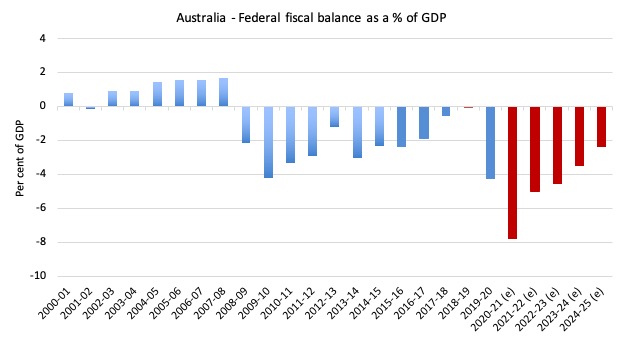
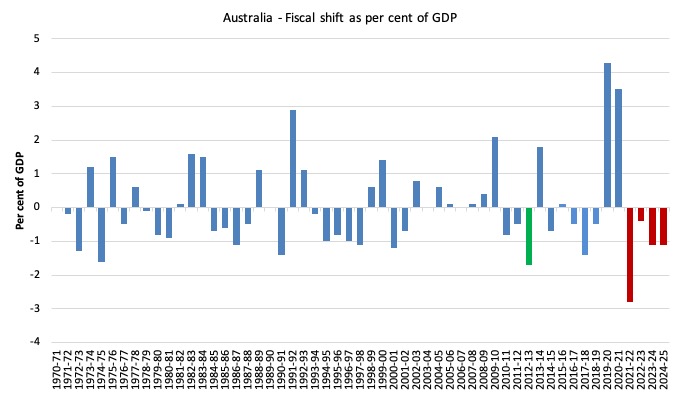
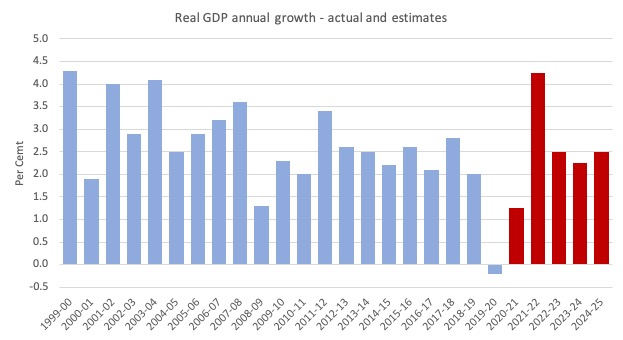
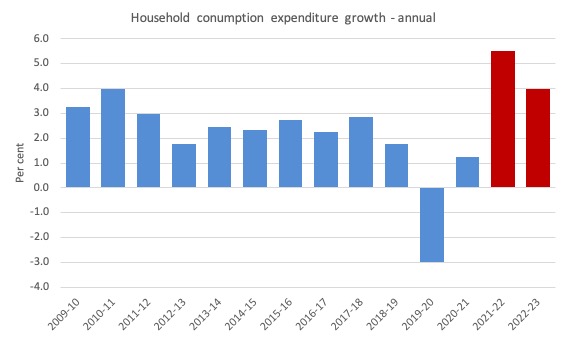
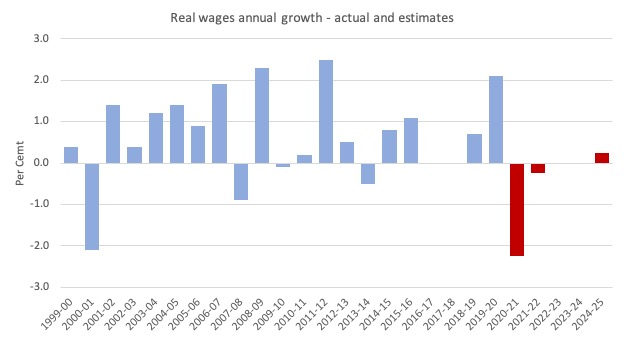
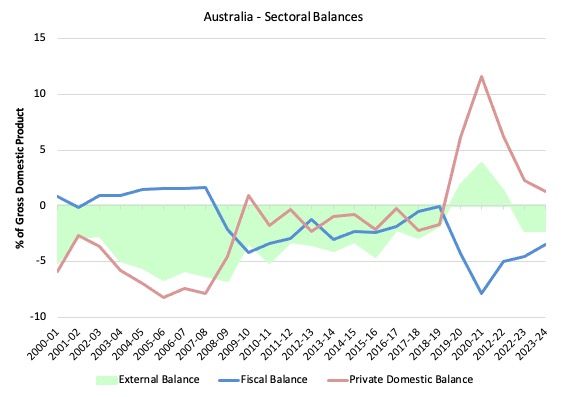
“As stupid as the British Labour Party having Keir Starmer as the leader.”
His job is secure as a consequence of the Wilson Rule – specifically, that the incumbent is safe while there’s no obvious successor.
“the Government is wanting us to return to the unsustainable situation where private debt escalates to maintain household consumption expenditure while wages growth remains flat.”
One wonders how long they expect this can continue now that we have finally exhausted conventional monetary policy and servicing private sector debt cannot be made much cheaper, if at all.
Shadow treasurer Chalmers was on Insiders last Sunday stating that FULL EMPLOYMENT in Australia was when the unemployment figure started with a 4.
Shame on him and his party. They deserted the working class years ago and are quite prepared to maintain a pool of unemployed to control wage growth.
Keep up the good work professor! Unlike the neo-liberal mud we have been taught, MMT is far more clear and understandable. The basic sectoral balance equation cannot be repeated often enough.
“This is an announcement government (with little action) and the actual bigger spending initiatives are not next year but in the hazy forward years which means we can largely disregard them.” Well I know, as an American, this feeling of frustration and cynicism, yet I find it helpful to keep in mind that we have been living in an entrenched global plutocracy for some forty or fifty years. Neoliberalism looked like the (sorry) end of history until the pandemic suddenly upset the social, political, and economic applecart, leaving the PTB precisely where they are now: scurrying around and trying to pick up the apples, reload the cart, get it moving again in the same exploitative, ecocidal direction. Yet something tells me that all of this scurrying around won’t work, that something fundamental has changed, something that cannot be contained or suppressed or reversed no matter how frantic the efforts of the PTB. More and more, I hear MMT talked about and embraced as obviously true on video shows created and watched by the young. More and more I hear even mainstream media give MMT some grudging respect, if only by finding it necessary to distort it or attempt to refute it. This pandemic that we are far from being finished with (think, for example, mutations and festering third-world slums) has forced us, despite ourselves, to focus on the health and wellbeing of people, which I believe will translate, is already translating, into the health and well-being of our planet. Thoughtful people knew we needed a great reset of our neoliberal capitalist way of life long before Covid reared its ugly head. Such a reset is happening IMHO, slowly, yes, but surely. And however faint the signs, however rhetorical they may be right now, however feeble the initial steps, two forward, one back, I think it would be a mistake to disregard them.
It might pay to consider that a significant leakage from the economy has been plugged for the time being – Australians can no longer go abroad, taking their spending with them. By some estimates it amounts to around $55 billion per year that now must be either saved or spent into the domestic economy. Perhaps they are banking on that being significant enough to offset the coming contraction.
Nice summary and analysis.
I concur that the incoherence in ABC coverage is marked and the ALP seem determined to wedge themselves.
Sad however that dropping the APS wage freeze is not one of your macroeconomic priorities.
Hi Bill
I agree with an earlier posting of yours re there being no need for the govt to borrow from financial markets and pay interest, given the RBA holds a substantial chunk of govt debt that it really doesn’t need to repay. Why does Lowe believe this must be repayed? We all know how much political power t financial markets exert, so this is probably the most formidable obstacle in the way of a govt’s taking up of MMT principles on a permanent / long term basis.Would there be any merit in increasing the sales of govt bonds on a preferential basis to non privately owned/industry super funds, so the govt’s current interest payments of $17+bn per annum would be shared/ more equitably distributed to Australian wage earners?
It seems to me that if the government wants to pay $17+billion to wage earners, they can do it. They don’t need to set up a tricky Rube Goldberg device with bonds that will maybe, eventually, pay wage earners if it all works right.
Any advantage would have to be a rhetorical advantage that gives the scheme a “better flavor”, or helps some similar way to get it implemented.
Pretty reasonable and sensible federal budgetary wish list Bill.
Pity the several idiots who wrote the federal budget didn’t include much of any of them.
I also noticed the lack of monetary and macroeconomic understanding at the ABC continued last night on Q&A. I’ve given up on writing to ABC news to contact you or Steven Hail to explain to reporters how it actually works, but I might try asking Jackie “I don’t want you kids to worry about paying your trillion dollars,” Lambie to in order for you to explain reality to her … If it works good.
The press are no better in Canada – it’s the fallacious household budget analogy all the time everywhere.
The only progress is that the deficit/debt hysterics are finding it more and more difficult to get any traction. The public appears increasingly inured to their gibbering.